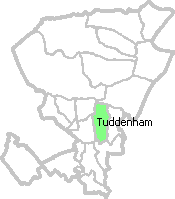Welcome to Tuddenham
 Evidence of occupation dating from the
Bronze Age has been found here although it was probably the Anglo Saxons who
made it a permanent settlement and gave it the name of 'Tuddenham (Tudda’s
home or enclosure) Evidence of occupation dating from the
Bronze Age has been found here although it was probably the Anglo Saxons who
made it a permanent settlement and gave it the name of 'Tuddenham (Tudda’s
home or enclosure)
 Tuddenham's
Species
Mon 18/12/00 Tuddenham's
Species
Mon 18/12/00
Recorded numbers of inhabitants date from then and range
from 26 people (heads of households) in 1086 to 379 at the 1991 census the peak
was in 1851 when there were 479.
In the 17th Century the plague reached here and 32
residents were buried in the churchyard in 1625 alone these included four from
the same Hoy family who all died within a few days of each other. Having always
been a rural area the majority of people were of the lower, labouring class and
employed in agriculture but there have been a few notable exceptions.
James Davies was inducted to the Tuddenham living on
Jan. 19th 1692, (as curate to Rev. Philip Le roy a Frenchman) and
during his 57 years in office he re wrote the church registers and probably
officiated at the burial of John Cockerton a local yeoman farmer in 1728.
Undoubtedly our most generous and notable benefactor the village children still
benefit from his generosity. One hunderred and fifty years before schooling
became compulsory for all children he, by his will of 1723, founded a free
school for the poor children of the village, the master to 'Read, write, account
and learn Latin as in other schools' He died without heir in 1728 and 270 years
later the Cockerton trust is still one of the
major charities of the village.
The water mill and manor of Tuddenham was acquired by John
the first Earl of Bristol in 1698 and after that he and succeeding members of
the family added substantially to the land and property within Tuddenham until
at the beginning of this century they owned almost all the village, exceptions
being the Church and Cockerton holdings. The Bristols gradually reduced their
holdings until in the mid 50's the last property and land was offered to tenants
and among these were the Kendalls, Browns, Spooners and Grimwoods, families that
have dominated our census returns for the last 150 years and are still prominent
in the village today
Long established families live beside people who have just
arrived and it is this blend of old and flew that makes Tuddenham St. Mary
Village Folk so fascinating today.
|
|
To explore our site simply click on any of the
main chapter headings at the top or this table of contents
opposite. You can also return to the main 22villages community
home page or visit our newsgroup. If you have any comments or
suggestions simply click on the small letter/envelope on the
left. |
|
|